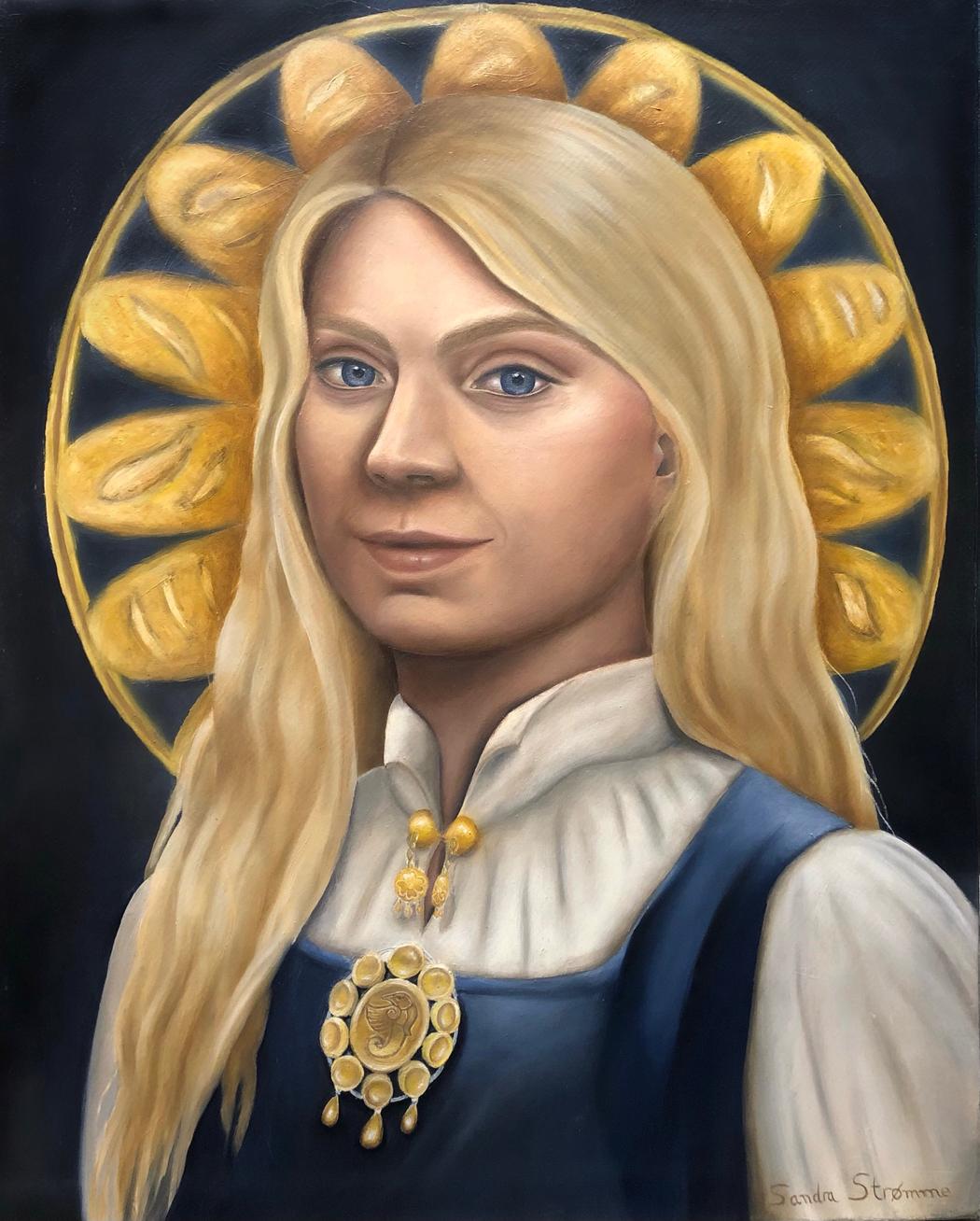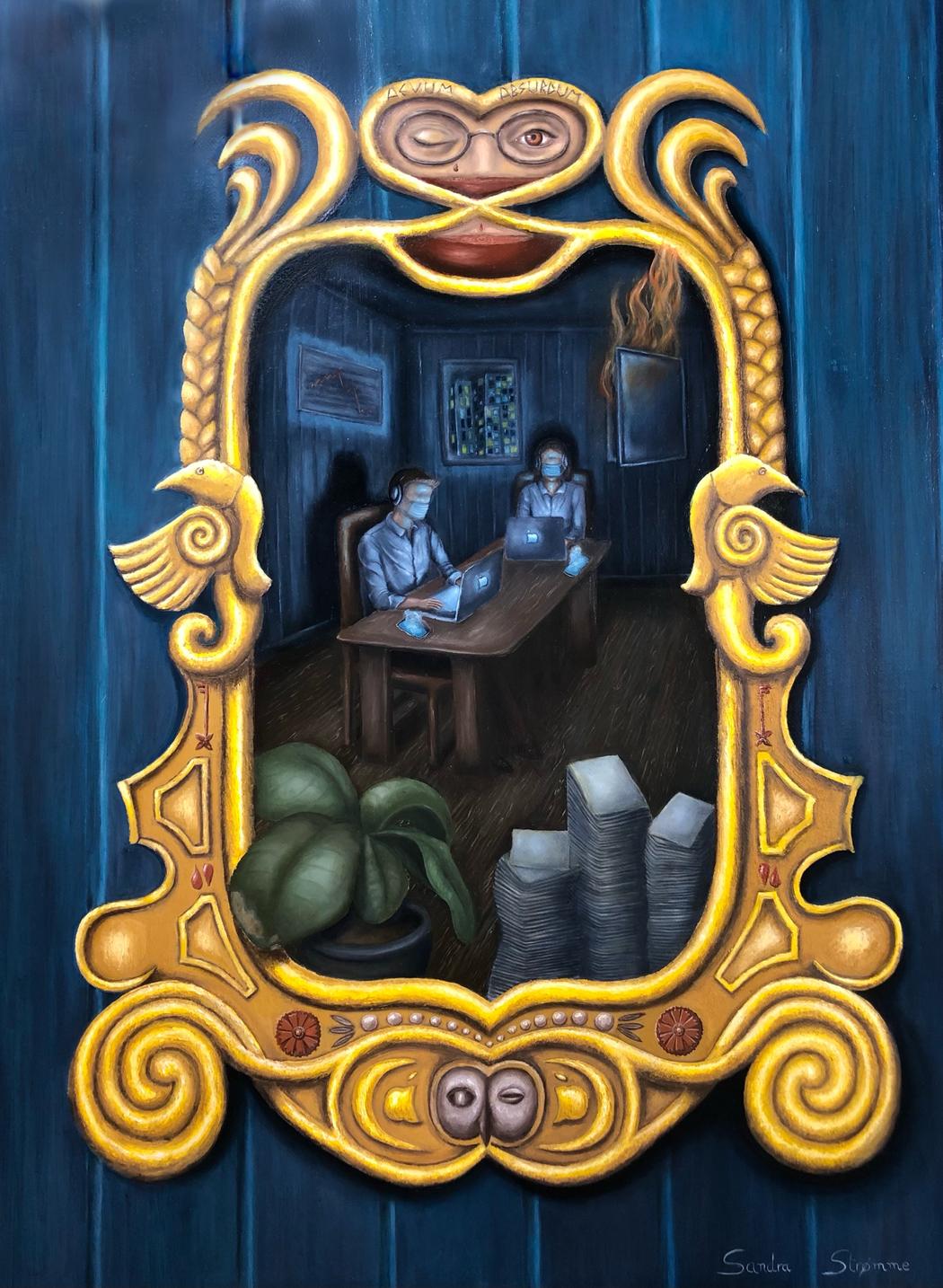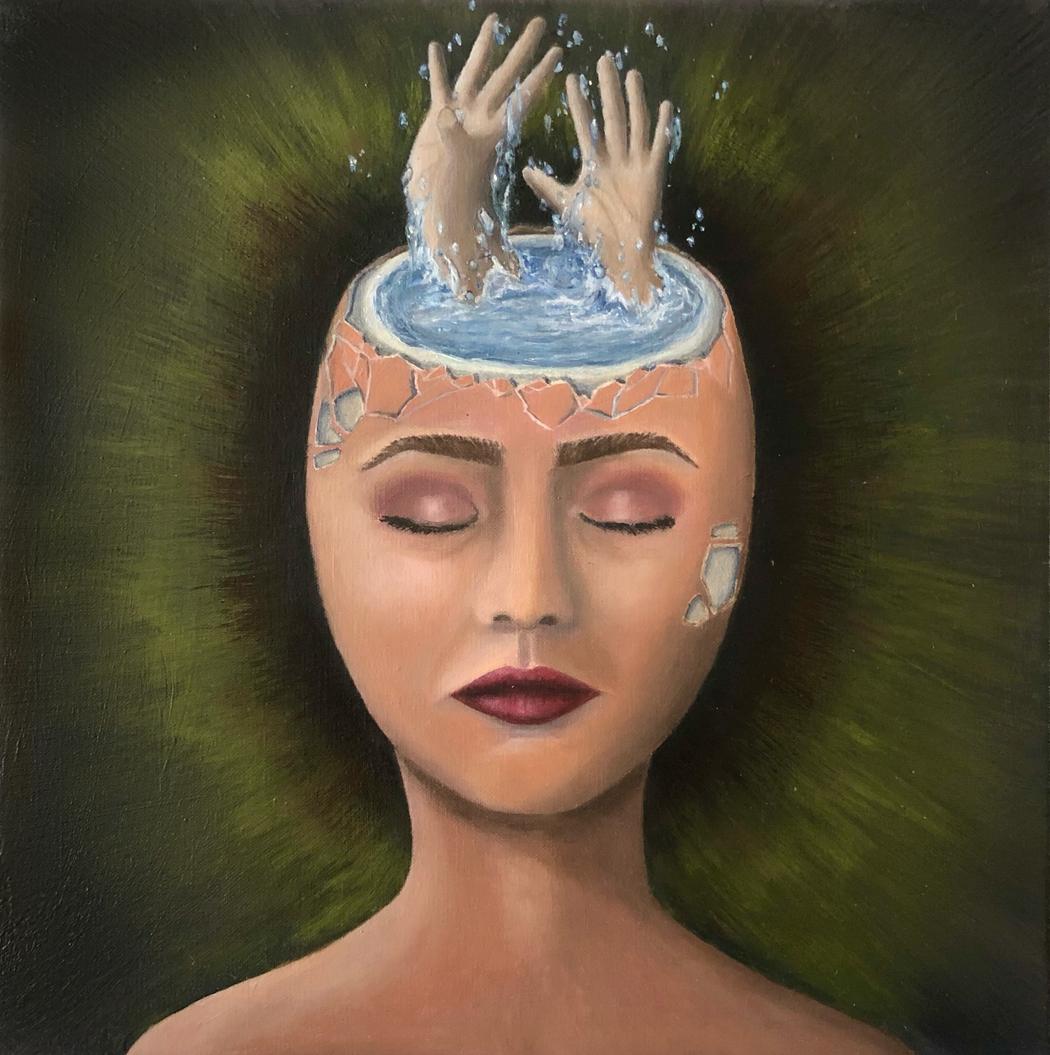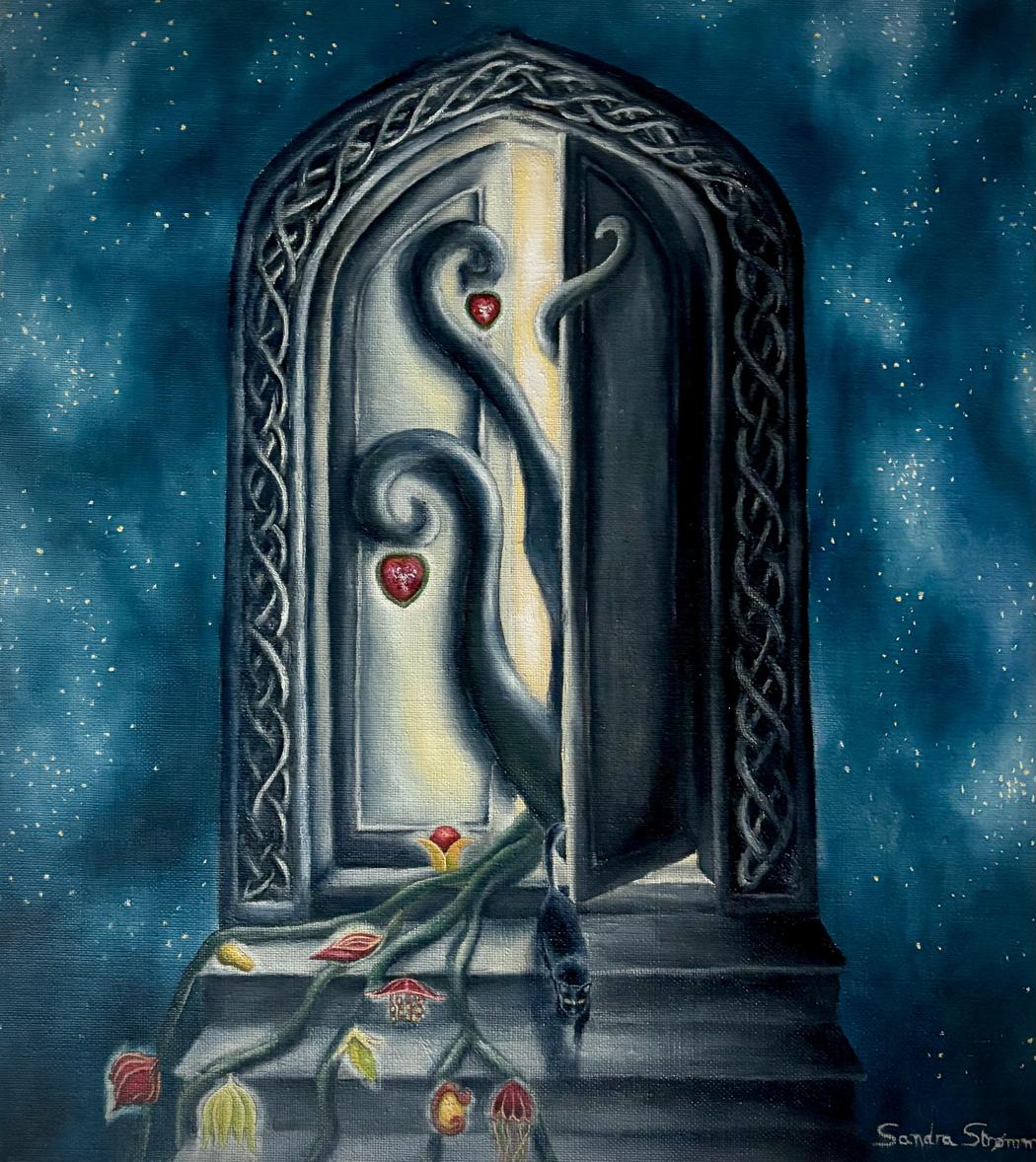Sandra Strømme
Year of birth: 1994
Where do you live: Between Paris and the South of France
Your education: Master of Fine Arts, Université Paris 1 Panthéon-Sorbonne; Master of Arts in Medieval History, King’s College London; Master’s degree in Journalism, École Supérieure de Journalisme de Paris; Bachelor’s degree in History of Art, University of Oslo; Bachelor’s degree in History of Ideas, University of Oslo
Describe your art in three words: Neo Nordic Surrealism
Your discipline: Oil painting, wood carving
Website | Instagram
 Sandra Strømme | Self Portrait | 2022
Sandra Strømme | Self Portrait | 2022
You describe your practice as “Neo-Nordic Surrealism.” Could you tell us more about what this means to you, and how you came to define this term?
My main practice is painting, often combined with carved wooden frames. From the start, surrealism simply emerged as my way of expressing myself artistically, and has become a sort of native language. I use it to explore ideas and feelings beyond words, filling my work with symbols. Because surrealism did not leave as strong a mark on Scandinavia during its peak as it did elsewhere, it felt instinctive to merge these impulses with Nordic elements.
Although my work draws on Nordic motifs and methods : knotwork, mythological themes, and inspiration from Viking woodcarving, it is not Nordic in a purely traditional sense. My art reflects the contemporary world, shaped by diverse cultural influences and modern concerns. At the same time, I look to renew these ancient techniques by using 3D modelling and CNC carving alongside hand tools, blending past and present approaches. That is why I call it Neo-Nordic: “neo” both in its themes and in how it is made.
Many of your works incorporate carved wooden frames with Nordic motifs. How do these sculptural elements interact with the painted image?
The interlaced motifs carved into the wooden frames are a visual metaphor for how past, present and future intertwine. By framing my paintings in these knot-like carvings, I want to suggest that art is timeless and universal. Despite differences that separate us from people of other time periods, the essential concerns of love, life and death remain constant. These sculptural frames highlight that these themes belong to a shared human story across time.
 Sandra Strømme | Aevum Absurdum | 2022
Sandra Strømme | Aevum Absurdum | 2022
How has your background in medieval history and journalism influenced your artistic storytelling?
My studies in medieval history have made me fascinated by how people once understood the world. They have also shown me that at our core, humans today are not so different from those who lived centuries ago. The so-called “Dark Ages” are often mischaracterised in my view. There was immense artistic and spiritual richness, and the medieval mind was often more open to a magical, symbolic world where mystery was embraced.
Journalism taught me how to shape a story. My paintings are very narrative, sometimes almost like small theatre scenes. Each one tells a story, inviting the viewer to decode it. Some are built on precise ideas, others more dreamlike or mysterious. In the end, I want viewers to step into the story themselves, finding meanings that resonate with their own subconscious. I believe in Jung’s idea of the collective unconscious, that what someone else sees in my work can be just as true as what I saw when I created it.
Some of your paintings, like The Dark Place or The Dinner Party, evoke a sense of psychological or emotional narrative. Are they based on personal experiences, dreams, or imagined stories?
All of the above. I draw inspiration from what I feel, think, dream, from stories I hear, books, films and fleeting impressions. Mostly, I paint the world as I live and see it. My art is a symbolic and imaginal reflection of that world.
The Dark Place and The Dinner Party both arose during difficult periods in my life, so they carry something personal, though they are also shaped by invention. There is ambiguity in both the works and I seek to pull the viewer into them: through a hand or through the faceless figures observing the viewer. By looking, you become part of it, an invisible guest at these gatherings.
 Sandra Strømme | Embrace The Chaos | 2021
Sandra Strømme | Embrace The Chaos | 2021
There is a recurring theme of doors, thresholds and inner spaces in your paintings. What do these symbolize in your work?
My work often features architectural elements like doors, rooms, and houses as symbolic thresholds into the subconscious. A door might suggest the passage between the conscious and the hidden, or between past and present, while an inner space can evoke a mental state. These settings mirror inner landscapes and invite viewers to wander through the architecture of the psyche. Interiors are not just physical structures but psychological gateways, urging us to explore memory and emotion and to confront parts of ourselves we might otherwise keep concealed.
How do Norse mythology and Carl Jung’s psychology intertwine in your creative process?
In Norse mythology, the gods Odin, Vili and Ve found two tree trunks on the shore and shaped them into the first humans, Ask and Embla. This story has always felt powerful and poetic to me, tying directly to my use of wood, which fascinates me not just as a material but almost as a living archive. Each growth ring marks a year, a cycle, a memory of weather and time, so when I carve wood, I am aware I am working with something that physically contains different periods layered within it.
Jung’s ideas about the collective unconscious, archetypes, and dream analysis give me a psychoanalytical framework for these stories and symbols. He saw dreams as messages from the deeper layers of the psyche, rich with universal imagery. When I combine carved wood with painting, it feels like bringing together material time, literally inscribed in the wood’s rings, with the timeless inner worlds of myth and the subconscious. It becomes a dialogue between physical traces of history and the deeper, shared symbols that live within us all.
 Sandra Strømme | The Cat Knows The Way | 2025
Sandra Strømme | The Cat Knows The Way | 2025
You have lived in countries as diverse as Myanmar, Italy and Singapore. Has your time abroad shaped your approach to Nordic identity or symbolism?
Very much so. I am Norwegian, but I have spent most of my life abroad. I love returning to Norway, but I do not see myself living there permanently. Being a foreigner feels natural to me; it keeps me questioning things and seeing them from different angles. Living in places so distant from Scandinavia has broadened my sense of identity, but it has also made me dig more deeply into my Nordic roots artistically. It is a way to stay connected, even when far away. My Nordic references are less about nationalism and more about tapping into a mythic, poetic language that anyone might relate to. In that sense, I hope that my work can become a meeting point for different worlds.

Leave a Reply
You must be logged in to post a comment.